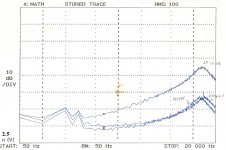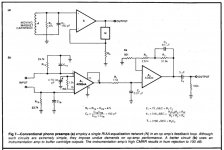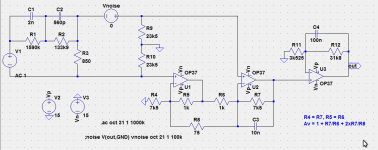In a balanced input the 47k load will be split into 2 x 23.5k, which will give less Johnson and less effect from current noise, but the voltage noise will be unaffected and there are now two uncorrelated sources of it.
The RLC of the motor circuit still sees 47K the contribution of the load resistor is unchanged. For your amusement a noise plot (unequalized) of several op-amps with a real Stanton cart, 47k, and recommended C.
Attachments
Last edited:
The RLC of the motor circuit still sees 47K the contribution of the load resistor is unchanged.
Certainly, the 47k is made up of 23.5k on each of the inputs, and they appear in series to the cartridge. But there are two lots of current noise now, and the Johnson of the load resistors has only fallen by root-2. The significant factor however, as far as I see it, is that there are now two uncorrelated sources of voltage noise rather than one. If you switch those off the noise output is almost the same for the unbalanced and balanced cases. I have ignored the noise from the amplifier doing the phase-summing of the two amplifiers.
I will do a diagram so we can be sure we are on the same hymn-sheet.
This is the situation I have in mind. So what do you think? A valid model?
Note the 'ground' at the mid-point of the cartridge is purely notional; there is no physical connection there.

Note the 'ground' at the mid-point of the cartridge is purely notional; there is no physical connection there.

Getting back to balanced MM inputs, I would like to hear what people think about the noise situation. Seems to me it must be worse.
In a balanced input the 47k load will be split into 2 x 23.5k, which will give less Johnson and less effect from current noise, but the voltage noise will be unaffected and there are now two uncorrelated sources of it.
Using cart parameters of 600R and 500mH, and 5534 opamps, I calculate that the balanced noise will be 1.1 dB higher.
There's no reason why a balanced input for the usual MM source shouldn't give a NF of 1dB or less. After all, this is done with cheapo THAT chips. You just have to design it to suit the 600R & 500mH.
Wayne's thread(s) shows one(two?) method(s) and he presents very detailed measurements.
5534's noise performance is almost perfect for the usual MM cartridge. Using 2 in series (like your balanced input) would be feeding it with 1/2 the impedance though. I'm surprised your calculations show as much as 1dB difference though. But your method does put 4 devices in series for Env though .. while Wayne still has only 2.
There's an old NS App. note which shows how to do these noise calculations properly with wonky source Z and frequency response, the example surprise surprise, being a MM preamp. Presumably you are using a method at least as sophisticated.
DouglasSelf said:That would be quite acceptable if balanced operation solved other problems, but I've yet to hear any convincing argument that it does.
If you are using your cartridge into an unbalanced preamp (like most people), you WILL get hum .. only the level is open to discussion.
Now here's an important and useful topic for your new book. I'll wager big money that 99% of people here, including the true gurus, have had problems with hum and unbalanced leads/preamps to phono cartridges.DouglasSelf said:Not true in my experience. Unmeasurable hum is possible if the ambient magnetic fields are low enough.
How about you explain in your new book how to achieve unmeasurable hum without having to rewire your tone arm and/or building the preamp in the arm? Practical stuff please.
It's all SME's fault. Before the 3009, many (most?) tone-arms used a 5p DIN connector or similar to take the 2 floating signals + shield. There's hum & RFI advantages doing this even with an unbalanced preamp. Arnold Sugden had an article in HFN in the 60's about this.
When SME introduced their (terrible) gold plated RCA plugs with extra long pins, everyone's high quality preamp had to use RCA sockets.
I will do a diagram so we can be sure we are on the same hymn-sheet.
Walt and I did this ages ago. There are several ways to substitute for the AD624 with commercial products or hybrid bi-polar/FET inputs. The key is the input noise ends up being on the order of a single op-amp solution, down below 1nV is easy, Wayne's are simply one example. The words here are Walt Jung's, he was invested in the advantage as far back as 1982.
Attachments
😱 I would never have suspected AD624 was suitable for MM.Walt and I did this ages ago. There are several ways to substitute for the AD624 with commercial products or hybrid bi-polar/FET inputs. The key is the input noise ends up being on the order of a single op-amp solution, down below 1nV is easy, Wayne's are simply one example.
My single brain cell is a bit tired so may I beg yus guru's help on the 'rithmetic.
The datasheet shows Current Noise about 300 femtoA/rt(Hz). This is equated to rt(4kTf / R) = 0.129nA rt(f/R) ie
300 x 10^-15 = .129 x 10^-9 rt(1/R)
rt(R) = 0.129e-9 / 300e-15 = 430
making the Noise Equivalent Current Resistor
Rni = 430^2 = 185k
Is this right?
Plis xcus if eye dun yus korect wuds cos kunt reed en rite 🙂
Last edited:
😱 I would never have suspected AD624 was suitable for MM.
This is what we had to sell, I thought I made it clear there are plenty of other solutions. BTW on noise alone the 624 does quite well the 5534 is 400fA/rt-Hz?.
I don't want to get side-tracked onto instrumentation amplifiers, useful though they may be.
I want to know if people agree that Post #84 above is a fair representation of the noise situation of a balanced MM input made with a pair of opamps.
I appreciate that the doubling up an expensive RIAA network is inelegant at best.
I want to know if people agree that Post #84 above is a fair representation of the noise situation of a balanced MM input made with a pair of opamps.
I appreciate that the doubling up an expensive RIAA network is inelegant at best.
Walt and I did this ages ago. There are several ways to substitute for the AD624 with commercial products or hybrid bi-polar/FET inputs. The key is the input noise ends up being on the order of a single op-amp solution, down below 1nV is easy, Wayne's are simply one example. The words here are Walt Jung's, he was invested in the advantage as far back as 1982.
I don't see how in the 2nd case the opamp demands (output opamp I presume are less than the top case?
Jan
I don't want to get side-tracked onto instrumentation amplifiers, useful though they may be.
I want to know if people agree that Post #84 above is a fair representation of the noise situation of a balanced MM input made with a pair of opamps.
I appreciate that the doubling up an expensive RIAA network is inelegant at best.
Sure, just that the op-amps shown are not the lowest noise solution. There also is probably a smart way to include less than two complete RIAA's.
They are pretty close if you accept that you are going to use two opamps in the circuit; however that gives you noise from 4 input devices rather than two. But my question remains, is it a valid noise model???Sure, just that the op-amps shown are not the lowest noise solution.
I hope there is, as the RIAA network is probably the dominant cost. However I am not going into it until I am convinced that a balanced MM input has something to offer.There also is probably a smart way to include less than two complete RIAA's.
They are pretty close if you accept that you are going to use two opamps in the circuit; however that gives you noise from 4 input devices rather than two. But my question remains, is it a valid noise model???
I hope there is, as the RIAA network is probably the dominant cost. However I am not going into it until I am convinced that a balanced MM input has something to offer.
I said sure, topologically there is no real difference here between this and the first two op-amps in a three op-amp in-amp.
It's not hard to do passive RIAA EQ with a single RIAA network in a balanced topology, you'd just split the first resistive element in the network across the balanced output of the first stage and place the RC and C across the inputs to the next stage. (per Lipshitz)
Doing active EQ would require very close matching of all components in both amplifier paths and would not be a direction I'd want to pursue.
Very interested in that book, regardless. 🙂
Doing active EQ would require very close matching of all components in both amplifier paths and would not be a direction I'd want to pursue.
Very interested in that book, regardless. 🙂
I have a balanced phono preamplifier MM design appearing at Elektor Spain in March 1985, I can not put it here, but if anyone is interested in a practical design, please, provide me by private message an email address so I can send it to you
kgrlee said:I would never have suspected AD624 was suitable for MM.
I immediately thought it would be a good replacement for Wayne's 'front-end'. Of course even non Golden Pinnae are just as prejudiced as the Audiophools so I would have a job convincing him 😀This is what we had to sell, I thought I made it clear there are plenty of other solutions. BTW on noise alone the 624 does quite well the 5534 is 400fA/rt-Hz?.
BTW, Wayne identifies all the good LN 'instrumentation amp' type topologies as originating from Demrow in Jurassic times, including his own, John Roberts' and Graeme Cohen's supa LN mike preamp. SSI/TI/THAT too if you allow some license. 😀 See the thread for details.
There must be modern FET instrumentation amps with low (<3.5nV/rt(Hz) ) Ein which would be even better for MM. Any suggestions Guru Wurcer?
__________________________
Well I suppose it 'works' if you feel 4 devices in series are OK for a LN device.I want to know if people agree that Post #84 above is a fair representation of the noise situation of a balanced MM input made with a pair of opamps.
The only thing missing is the 'recommended C' that Guru Wurcer includes in his measurements. The NI app note does too.
Don't see why you need to show explicit noise sources. LTspice will do it all for you including the resistor noise. You ARE including the resistor noise ... especially the 47k. see the NI app note.
Won't comment on double RIAA networks except to say it doubles your chance to claim Unobtainium bits hand carved from solid by virgins. 🙂
__________________________
DouglasSelf said:I am not going into it until I am convinced that a balanced MM input has something to offer.
99% find this difficult, if not impossible. The 1% appears to be Guru Self.Not true in my experience. Unmeasurable hum is possible if the ambient magnetic fields are low enough.
If you've achieved this with an unbalanced input and the usual 2m phono leads, this is a worthy subject in your new book.
Please detail the turntable, arm, cartridge, leads, earthing system and the measuring system. As this is a measurement I presume it is real life. Does this system still exist?
There's a number of caveats to achieving low hum in a phono system that are probably only familiar to the ancients versed in these arcane arts.
eg In some turntables, the platter sits on a steel ball which sits on a PTFE pad for low rumble. But this means the platter is only unreliably earthed via the bearing sleeve .. assuming it is conductive metal.
The EVIL SME system (now mandatory with Audiophool arms) with fancy RCA cables needs special attention as it is probably the most common use case for fancy preamps today.
Last edited:
I don't follow you here. Any chance of a diagram?It's not hard to do passive RIAA EQ with a single RIAA network in a balanced topology, you'd just split the first resistive element in the network across the balanced output of the first stage and place the RC and C across the inputs to the next stage. (per Lipshitz)
That might not be as bad as it sounds. The RIAA networks have to be accurate for accurate RIAA, and that may well be good enough for practical CMRR.Doing active EQ would require very close matching of all components in both amplifier paths and would not be a direction I'd want to pursue.
Very interested in that book, regardless. 🙂
But where is the unwanted common-mode signal coming from?
BTW, Wayne identifies all the good LN 'instrumentation amp' type topologies as originating from Demrow in Jurassic times, including his own, John Roberts' and Graeme Cohen's supa LN mike preamp. SSI/TI/THAT too if you allow some license. 😀 See the thread for details.
As I have said before, I would love to read that thread, but the link in post #51 does not work.
It's not supposed to be optimal. The purpose is to ask if it is a valid model of how a floating MM coil interfaces with a balanced input.Well I suppose it 'works' if you feel 4 devices in series are OK for a LN device.
The only thing missing is the 'recommended C' that Guru Wurcer includes in his measurements. The NI app note does too.
So far I understand that the people here think it is. Anyone disagree?
Perhaps, but I don't want it all done for me. I want understand it in detail.Don't see why you need to show explicit noise sources. LTspice will do it all for you including the resistor noise. You ARE including the resistor noise ... especially the 47k. see the NI app note.
Doing active EQ would require very close matching of all components in both amplifier paths and would not be a direction I'd want to pursue.
Not so (pls see attachment) if you don't require it to differential all the way.
Regarding noise in differential RIAA - would it be correct to regard the two inputs as in parallel, as often seen in MC head amps, noise-wize?
Attachments
- Home
- Source & Line
- Analogue Source
- What would you want to see in a book on electronics for vinyl replay? Douglas Self.


